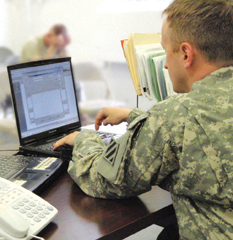


ACCESS TO CARE ![]()
ABOUT ARMY MEDICINE
ARMY MEDICINE PORTAL (AKO Users)
LEADERS
ORGANIZATION
BALANCED SCORECARD (AKO Users)
HEALTHCARE COVENANT
AMBASSADOR PROGRAM
NEWS &
INFORMATION
OMBUDSMAN
PROGRAM
FOIA/PRIVACY ![]()
JOBS & TRAINING
REPORTS
TRICARE® ![]()
WOUNDED SOLDIER AND FAMILY HOTLINE
MERCURY NEWSPAPER
AMEDD VIRTUAL LIBRARY ![]()
WARRIOR MEDIC
MEMORIAL ![]()
Field Electronic Records Come to Garrison
News & Information - The Mercury - July 2009 Mercury
by Bill Snethen
MC4
 |
|
| PFC Don Pickering Jr., a medic for the 603rd Aviation Support Battalion, checks in a patient at the aviation clinic on Hunter Army Airfield, Ga. (Photo by MC4) |
The 3rd Infantry Division has expanded its use of the Army's battlefield electronic medical recording (EMR) system, Medical Communications for Combat Casualty Care (MC4), to two more garrison aid stations at Fort Stewart, Ga. The 1st Battalion, 64th Armor and 26th Brigade Support Battalion joined the Special Troops Battalion Aid Station at Fort Stewart and the 603rd Aviation Support Battalion at Hunter Army Airfield in Savannah, Ga., as the first group of 21 garrison aid stations led by the 3rd ID to discontinue the use of paper medical records.
The implementation of the digital medical recording system by the 3rd ID, and the 82nd Airborne Division at Fort Bragg, N.C., has resulted in capturing 3,000 electronic patient encounters in garrison. The use of MC4 at battalion aid stations in the U.S. not only provides an EMR capability for clinics with low-to-no connectivity, but supports a new initiative by the Army to "train as you fight" with MC4.
"The primary benefit of this endeavor is the training and habituation that improves through continued use," said LTC Edward Michaud, 3rd ID surgeon. "Utilizing the EMR system on a daily basis in garrison reduces future training requirements and helps to eliminate any delay service members may experience in receiving medical care."
In addition to training, Soldiers that visit the clinics on post also benefit from the use of MC4.
"The staff is able to provide enhanced care since they now have the ability to quickly access historical information and view previous illnesses and treatments," Michaud said. "Without an EMR, aid stations primarily screen patients. Today, the 3rd ID has four aid stations with the ability to electronically capture patient encounters, document notes and reorder medications. Use of the MC4 system offers a significant benefit to the Soldier and the unit while in garrison that was not previously available.
CPT Christina Johnson, physician assistant at the 3rd ID's STB Aid Station, used the MC4 system in 2008 while deployed to Camp Buehring, Kuwait.
"MC4 was very effective when we conducted sick call in theater," Johnson said. "We supported a post with approximately 20,000 service members, contactors and foreign nationals who worked on site. I saw approximately 30 patients a day and all of the information was collected in the outpatient program. If I had to hand-write the patient information onto paper forms, the process of seeing patients and charting the care would have been very slow."
Traditionally, the buildings that house the aid stations are not wired into the local computer network. This can be a setback when trying to install an EMR system into the facility.
Connectivity is required in order to transmit patient data to the central data repository, where it comprises a Soldier's longitudinal health record and becomes immediately available to other medical personnel, regardless of location.
"The technical staff has worked tirelessly to hammer out technical issues, as well as uncover solutions to the networking challenge," Michaud said.
As a result of the collaboration, more garrison aid stations have connectivity to the local networks via a secure wireless channel—Combat Service Support Automated Information Systems Interface (CAISI).
Michaud acknowledges that in addition to organizational collaboration, user support has been key.
"If the providers were not happy with the system, then I would be very hesitant to move forward and continue the effort," Michaud said. "Many are familiar with the system from previous deployments. They see the benefits and understand the importance of its use. We now have the advantage of taking better care of our Soldiers in the states and during future deployments. We also benefit from having the medical staff and technical support personnel practice using the system on a daily basis. This is a win-win for everybody.
From the July 2009 Mercury, an Army Medical Department publication.




